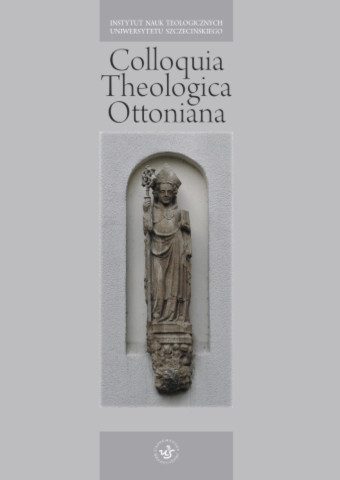
ISSN: 1731-0555
eISSN: 2353-2998
OAI
DOI: 10.18276/cto.2018.2-06




Issue archive /
2/2018
ΟὐΔ´ ἈΡΕΤῊ ΦΙΛΌΤΗΤΟΣ ἈΠΌΠΡΟΘΕΝ – antyczny Kościół wobec kryzysu rzymskiego małżeństwa
(ΟὐΔ´ ἈΡΕΤῊ ΦΙΛΌΤΗΤΟΣ ἈΠΌΠΡΟΘΕΝ – the ancient Church and the crisis of roman marrage)
| Authors: |
Jarosław
Nowaszczuk
Wydział Teologiczny Uniwersytet Szczeciński |
| Keywords: | marriage in ancient times Fathers of the Church and marriage Christian family prostitution in ancient times Church and prostitution |
| Data publikacji całości: | 2018 |
| Page range: | 18 (111-128) |
Abstract
In the first centuries after Christ, the institution of marriage and family experienced a visible crisis in the Roman Empire. Christianity, when developing within the structures of the pagan state, could not avoid confrontation with the realities of life. The scriptures from the works of the Fathers of the Church and the decisions of the Synods of Bishops argue that the community of faith also had to respond to a whole range of offences within it, and even aberrations of the marital life, being described collectively as πορνεία or fornicatio. The documents argue that a strict but clearly defined set of sanctions was used to correct the behaviour of Christians, among which the most important one was deprivation of the participation in the life of the Church and denial of the Eucharist. Converted sinners could return to the community after doing penance determined by the Bishop being fulfilled in the form of exomologesis. Over time, there were homilies, catecheses and treatises by the greatest Fathers of the Church where the orthodox doctrine concerning the union of a man and a women was expounded. They recognised not only its value but also showed it as one of the paths for sanctification and achieving moral perfection, an alternative to the life of celibacy.
Download file
Article file
Bibliography
| 1. | Ancyrranum Concilium, w: Sacrorum Conciliorum nova et amplissima collectio […], J. D. Mansi (ed.), Expensis A. Zatta Veneti, Florentiae 1759, t. 2, kol. 513–540. |
| 2. | Baron A. ks., Kobieta w świadectwach Kościoła starożytnego, w: Kobieta w Kościele: materiały z sesji ekumenicznej zorganizowanej przez Międzywydziałowy Instytut Ekumenii i Dialogi Uniwersytetu Papieskiego Jana Pawła II w Krakowie oraz Oddział Krakowski Polskiej Rady Ekumenicznej 18 listopada 2008 roku, red. Ł. Kamykowski, Z. J. Kijas, A. Napiórkowski, Kraków 2011, s. 9–53. |
| 3. | Carcopino J., Życie codzienne w Rzymie w okresie rozkwitu cesarstwa, tłum. M. Pąkcińska, Warszawa 1960. |
| 4. | Concilium Eliberitanum, w: Sacrorum Conciliorum nova et amplissima collectio […], J. D. Mansi (ed.), Expensis A. Zatta Veneti, Florentiae 1759, t. 2, kol. 1–406. |
| 5. | Constitutiones Sanctorum Apostolorum, w: Sacrorum Conciliorum nova et amplissima collectio […], J. D. Mansi (ed.), Expensis A. Zatta Veneti, Florentiae 1759, t. 1, kol. 257–596. |
| 6. | Nathan G., The Family in Late Antiquity. The rise of Christianity and the endurance of tradition, London and New York 2002. |
| 7. | Nehring P., Dlaczego dziewictwo jest lepsze niż małżeństwo? Spór o ideał w chrześcijaństwie zachodnim końca IV wieku w relacji Ambrożego, Hieronima i Augustyna, Toruń 2005. |
| 8. | Pierwsi świadkowie. Wybór najstarszych pism chrześcijańskich, tłum. A. Świderkówna, opr. ks. M. Starowieyski, Kraków 1985. |
| 9. | Wright D.F., Nierząd, w: Słownik wiedzy biblijnej, red. M. Metzger, M. D. Coogan, konsult. wyd. W. Chrostowski, Warszawa 1996, s. 565. |